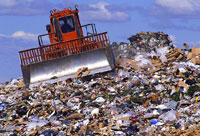Mankind May Soon Suffocate in Its Own Garbage
The volume of solid domestic waste discharged in the Earth’s biosphere has reached a geological figure – over 400 million tons a year. Such an enormous amount of waste affects global geochemical cycles. For example, the discharge of organic carbon – 85 million tons a year – doubles its natural absorption in the soil mantle – 42 million tons a year.

The majority of modern cities in the world have become a serious source of garbage, especially when it comes to packaging materials. In Russia, the situation was a lot better during the Soviet times, when an average Soviet citizen would produce a tenfold smaller amount of garbage than an average resident of Europe. There were no plastic bags in Soviet grocery stores. The numbers have become equal now. Each Russian city resident produces over 300 kilos of solid domestic waste every year.
Moscow produces over 15 million of waste a year. Eighty percent of this garbage cannot be recycled. More than a half of landfills in Russia do not meet the sanitary and ecological norms, a statement from the Federal Service for Supervision of Nature said. Chemically and biologically hazardous waste (mercury-containing items, fluorescent bulbs, various chemically active and toxic substances, medical waste, etc) is often delivered to landfills.
Russia has accumulated over 90 billion tons of solid domestic waste, and only 30 percent of this amount can be recycled or destroyed.
One of the largest landfills in Russia is located in the Moscow region. The Istrinsky Landfill is only a 40-minute drive from Moscow, about 500 meters far from the Istra River, which is a source of drinking water for Moscow. A huge pile of garbage, the height of a ten-storeyed building and the size of a soccer stadium can be seen from space.
Over 250 garbage trucks arrive to the landfill daily. Each KamAZ truck delivers 15 cubic meters of waste. The huge dump has earned the reputation of a ‘death factory’ for the local population. It contains hazardous medical waste – amputated limbs, blood transfusion systems, disposable syringes, expired medications, etc.
It goes without saying that the ground waters and the soil around the Istrinsky Landfill are entirely contaminated with toxic substances and pathogenic microorganisms. The water in the Istra River can be easily contaminated too after a heavy rainfall or snow melting. It may trigger serious epidemic such as cholera, plague and others.
There are over 50 other gigantic landfills surrounding Moscow, each of them taking the square of tens of hectares of land.
The situation in the rest of the world is far from being better. The plastic soup of waste floating in the Pacific Ocean has already doubled the square of the continental part of the United States. In 2004, the island of garbage weighed about 3 million tons, which is six times as much as the amount of natural plankton.
Plastic waste kills over 1 million sea birds and over 100,000 sea mammals a year. Zoologists may often find syringes, cigarette lighters and toothbrushes in the stomachs of dead animals, fish and birds.
In 1998, the USA produced 220 million tons of solid waste. That means that every American was producing about 2.5 kilos of waste every day.
About 315 million computers were discarded in the USA in 2004. Thus, the nation produces 220 million tons of electronic waste. Ten percent of this amount is deposited in US landfills, while 80 percent is shipped to China, India and Pakistan.
Nezavisimaya Gazeta
Also read: Obama's picture found on trash bins in Estonia
Subscribe to Pravda.Ru Telegram channel, Facebook, RSS!





